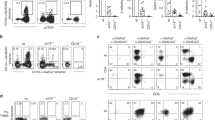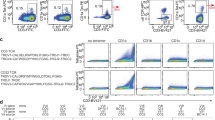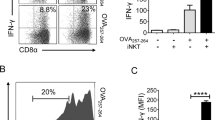Abstract
The most potent foreign antigens for natural killer T cells (NKT cells) are α-linked glycolipids, whereas NKT cell self-reactivity involves weaker recognition of structurally distinct β-linked glycolipid antigens. Here we provide the mechanism for the autoreactivity of T cell antigen receptors (TCRs) on NKT cells to the mono- and tri-glycosylated β-linked agonists β-galactosylceramide (β-GalCer) and isoglobotrihexosylceramide (iGb3), respectively. In binding these disparate antigens, the NKT cell TCRs docked onto CD1d similarly, achieving this by flattening the conformation of the β-linked ligands regardless of the size of the glycosyl head group. Unexpectedly, the antigenicity of iGb3 was attributable to its terminal sugar group making compensatory interactions with CD1d. Thus, the NKT cell TCR molds the β-linked self ligands to resemble the conformation of foreign α-linked ligands, which shows that induced-fit molecular mimicry can underpin the self-reactivity of NKT cell TCRs to β-linked antigens.
This is a preview of subscription content, access via your institution
Access options
Subscribe to this journal
Receive 12 print issues and online access
$209.00 per year
only $17.42 per issue
Buy this article
- Purchase on Springer Link
- Instant access to full article PDF
Prices may be subject to local taxes which are calculated during checkout




Similar content being viewed by others
Change history
04 August 2011
In the version of this article initially published online, in the diagrams at right in Figure 1, α-GalCer incorrectly included a second NH group and the acyl chain length of iGb3 was incorrect. The error has been corrected for the print, PDF and HTML versions of this article.
References
Rudolph, M.G., Stanfield, R.L. & Wilson, I.A. How TCRs bind MHCs, peptides, and coreceptors. Annu. Rev. Immunol. 24, 419–466 (2006).
Takada, K. & Jameson, S.C. Naive T cell homeostasis: from awareness of space to a sense of place. Nat. Rev. Immunol. 9, 823–832 (2009).
Harkiolaki, M. et al. T cell-mediated autoimmune disease due to low-affinity crossreactivity to common microbial peptides. Immunity 30, 348–357 (2009).
Hogquist, K.A., Baldwin, T.A. & Jameson, S.C. Central tolerance: learning self-control in the thymus. Nat. Rev. Immunol. 5, 772–782 (2005).
Godfrey, D.I. et al. Antigen recognition by CD1d-restricted NKT T cell receptors. Semin. Immunol. 22, 61–67 (2010).
Godfrey, D.I. & Rossjohn, J. New ways to turn on NKT cells. J. Exp. Med. 208, 1121–1125 (2011).
Cerundolo, V., Silk, J.D., Masri, S.H. & Salio, M. Harnessing invariant NKT cells in vaccination strategies. Nat. Rev. Immunol. 9, 28–38 (2009).
Godfrey, D.I., MacDonald, H.R., Kronenberg, M., Smyth, M.J. & Van Kaer, L. NKT cells: what's in a name? Nat. Rev. Immunol. 4, 231–237 (2004).
Gumperz, J.E. et al. Murine CD1d-restricted T cell recognition of cellular lipids. Immunity 12, 211–221 (2000).
Kinjo, Y. et al. Natural killer T cells recognize diacylglycerol antigens from pathogenic bacteria. Nat. Immunol. 7, 978–986 (2006).
Borg, N.A. et al. CD1d-lipid-antigen recognition by the semi-invariant NKT T-cell receptor. Nature 448, 44–49 (2007).
Pellicci, D.G. et al. Differential recognition of CD1d-α-galactosyl ceramide by the Vβ8.2 and Vβ7 semi-invariant NKT T cell receptors. Immunity 31, 47–59 (2009).
Wun, K.S. et al. A molecular basis for the exquisite CD1d-restricted antigen specificity and functional responses of natural killer T cells. Immunity 34, 327–339 (2011).
Aspeslagh, S. et al. Galactose-modified iNKT cell agonists stabilized by an induced fit of CD1d prevent tumour metastasis. EMBO J. 30, 2294–2305 (2011).
Uldrich, A.P. et al. A semi-invariant Vα10+ T cell antigen receptor defines a population of natural killer T cells with distinct glycolipid antigen–recognition properties. Nat. Immunol. 12, 616–623 (2011).
Li, Y. et al. The Vα14 invariant natural killer T cell TCR forces microbial glycolipids and CD1d into a conserved binding mode. J. Exp. Med. 207, 2383–2393 (2010).
Chiu, Y.H. et al. Multiple defects in antigen presentation and T cell development by mice expressing cytoplasmic tail–truncated CD1d. Nat. Immunol. 3, 55–60 (2002).
Brigl, M. & Brenner, M.B. How invariant natural killer T cells respond to infection by recognizing microbial or endogenous lipid antigens. Semin. Immunol. 22, 79–86 (2010).
Ortaldo, J.R. et al. Dissociation of NKT stimulation, cytokine induction, and NK activation in vivo by the use of distinct TCR-binding ceramides. J. Immunol. 172, 943–953 (2004).
Parekh, V.V. et al. Quantitative and qualitative differences in the in vivo response of NKT cells to distinct α- and β-anomeric glycolipids. J. Immunol. 173, 3693–3706 (2004).
Matulis, G. et al. Innate-like control of human iNKT cell autoreactivity via the hypervariable CDR3β loop. PLoS Biol. 8, e1000402 (2010).
Zhou, D. et al. Lysosomal glycosphingolipid recognition by NKT cells. Science 306, 1786–1789 (2004).
Wu, D.Y., Segal, N.H., Sidobre, S., Kronenberg, M. & Chapman, P.B. Cross-presentation of disialoganglioside GD3 to natural killer T cells. J. Exp. Med. 198, 173–181 (2003).
Koch, M. et al. The crystal structure of human CD1d with and without α-galactosylceramide. Nat. Immunol. 6, 819–826 (2005).
Zajonc, D.M. et al. Structure and function of a potent agonist for the semi-invariant natural killer T cell receptor. Nat. Immunol. 6, 810–818 (2005).
Zajonc, D.M. et al. Structural basis for CD1d presentation of a sulfatide derived from myelin and its implications for autoimmunity. J. Exp. Med. 202, 1517–1526 (2005).
Zajonc, D.M., Savage, P.B., Bendelac, A., Wilson, I.A. & Teyton, L. Crystal structures of mouse CD1d-iGb3 complex and its cognate Vα14 T cell receptor suggest a model for dual recognition of foreign and self glycolipids. J. Mol. Biol. 377, 1104–1116 (2008).
Mallevaey, T. et al. T cell receptor CDR2β and CDR3β loops collaborate functionally to shape the iNKT cell repertoire. Immunity 31, 60–71 (2009).
Mallevaey, T. et al. A molecular basis for NKT cell recognition of CD1d-self-antigen. Immunity 34, 315–326 (2011).
Wei, D.G., Curran, S.A., Savage, P.B., Teyton, L. & Bendelac, A. Mechanisms imposing the Vβ bias of Vα14 natural killer T cells and consequences for microbial glycolipid recognition. J. Exp. Med. 203, 1197–1207 (2006).
Christiansen, D. et al. Humans lack iGb3 due to the absence of functional iGb3-synthase: implications for NKT cell development and transplantation. PLoS Biol. 6, e172 (2008).
Porubsky, S. et al. Normal development and function of invariant natural killer T cells in mice with isoglobotrihexosylceramide (iGb3) deficiency. Proc. Natl. Acad. Sci. USA 104, 5977–5982 (2007).
Gapin, L. iNKT cell autoreactivity: what is 'self' and how is it recognized? Nat. Rev. Immunol. 10, 272–277 (2010).
Speak, A.O. et al. Implications for invariant natural killer T cell ligands due to the restricted presence of isoglobotrihexosylceramide in mammals. Proc. Natl. Acad. Sci. USA 104, 5971–5976 (2007).
Schümann, J., Mycko, M.P., Dellabona, P., Casorati, G. & Macdonald, H.R. Cutting edge: influence of the TCR Vβ domain on the selection of semi-invariant NKT cells by endogenous ligands. J. Immunol. 176, 2064–2068 (2006).
Brigl, M. et al. Conserved and heterogeneous lipid antigen specificities of CD1d-restricted NKT cell receptors. J. Immunol. 176, 3625–3634 (2006).
Xia, C. et al. Modification of the ceramide moiety of isoglobotrihexosylceramide on its agonist activity in stimulation of invariant natural killer T cells. J. Med. Chem. 50, 3489–3496 (2007).
Florence, W.C. et al. Adaptability of the semi-invariant natural killer T-cell receptor towards structurally diverse CD1d-restricted ligands. EMBO J. 28, 3579–3590 (2009).
Colf, L.A. et al. How a single T cell receptor recognizes both self and foreign MHC. Cell 129, 135–146 (2007).
Macdonald, W.A. et al. T cell allorecognition via molecular mimicry. Immunity 31, 897–908 (2009).
Tynan, F.E. et al. A T cell receptor flattens a bulged antigenic peptide presented by a major histocompatibility complex class I molecule. Nat. Immunol. 8, 268–276 (2007).
Yin, N. et al. Alpha anomers of iGb3 and Gb3 stimulate cytokine production by natural killer T cells. ACS Chem. Biol. 4, 191–197 (2009).
Rudd, P.M., Elliott, T., Cresswell, P., Wilson, I.A. & Dwek, R.A. Glycosylation and the immune system. Science 291, 2370–2376 (2001).
Petrescu, A.-J., Milac, A.-L., Petrescu, S.M., Dwek, R.A. & Wormald, M.R. Statistical analysis of the protein environment of N-glycosylation sites: implications for occupancy, structure, and folding. Glycobiology 14, 103–114 (2004).
Scott-Browne, J.P. et al. Germline-encoded recognition of diverse glycolipids by NKT cells. Nat. Immunol. 8, 1105–1113 (2007).
Arden, B. et al. Mouse T-cell receptor variable gene segment families. Immunogenetics. 42, 455–500 (1995).
Leslie, A.G. The integration of macromolecular diffraction data. Acta Crystallogr. D Biol. Crystallogr. 62, 48–57 (2006).
Emsley, P. & Cowtan, K. Coot: model-building tools for molecular graphics. Acta Crystallogr. D Biol. Crystallogr. 60, 2126–2132 (2004).
Zwart, P.H. et al. Automated structure solution with the PHENIX suite. Methods Mol. Biol. 426, 419–435 (2008).
CCP4 (Collaborative Computational Project, 4). The CCP4 suite: programs for protein crystallography. Acta Crystallogr. D Biol. Crystallogr. 50, 760–763 (1994).
Acknowledgements
We thank F. Carbone for critically reading the manuscript; K. Wun, R. Koh and M. Sandoval for assistance; and J. Vivian and the staff at the MX2 beamline of the Australian synchrotron for assistance with data collection. Supported by the Cancer Council of Victoria, the National Health and Medical Research Council of Australia, the Australian Research Council, The Royal Society (G.S.B.), The Wellcome Trust (084923/B/08/Z to G.S.B.), the Medical Research Council (G1001750 to G.S.B.) and the US National Institutes of Health (AI45889 to S.A.P., and AI076463 and AI078246 to L.G.).
Author information
Authors and Affiliations
Contributions
D.G.P. and A.J.C., isolation and characterization of NKT cell TCR–CD1d–β-antigen complexes; T.B. and A.P.U., surface plasmon resonance studies; J.L.N., crystallographic analyses; T.M., functional studies; O.P., crystallization and solution of the structure of the human NKT cell TCR complex; G.S.B., S.A.P. and J.M., intellectual input; and L.G., D.I.G. and J.R., investigation leadership and project conception. L.G., D.I.G. and J.R. contributed equally to this work.
Corresponding authors
Ethics declarations
Competing interests
S.A.P. has received payments as a consultant for Vaccinex for work related to the development of therapeutics based on CD1d-presented glycolipids.
Supplementary information
Supplementary Text and Figures
Supplementary Figures 1–3 and Tables 1–7 (PDF 3601 kb)
Rights and permissions
About this article
Cite this article
Pellicci, D., Clarke, A., Patel, O. et al. Recognition of β-linked self glycolipids mediated by natural killer T cell antigen receptors. Nat Immunol 12, 827–833 (2011). https://doi.org/10.1038/ni.2076
Received:
Accepted:
Published:
Issue Date:
DOI: https://doi.org/10.1038/ni.2076
This article is cited by
-
A single-domain bispecific antibody targeting CD1d and the NKT T-cell receptor induces a potent antitumor response
Nature Cancer (2020)
-
T cell receptor cross-reactivity expanded by dramatic peptide–MHC adaptability
Nature Chemical Biology (2018)
-
Molecular recognition of microbial lipid-based antigens by T cells
Cellular and Molecular Life Sciences (2018)
-
Reconstitution models to evaluate natural killer T cell function in tumor control
Immunology & Cell Biology (2016)
-
Atypical natural killer T-cell receptor recognition of CD1d–lipid antigens
Nature Communications (2016)



